Papers by Abu Mitul, Ph.D.
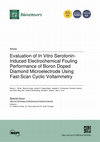
Biosensors, 2024
Fast-scan cyclic voltammetry (FSCV) is an electrochemical sensing technique that can be
used for ... more Fast-scan cyclic voltammetry (FSCV) is an electrochemical sensing technique that can be
used for neurochemical sensing with high spatiotemporal resolution. Carbon fiber microelectrodes
(CFMEs) are traditionally used as FSCV sensors. However, CFMEs are prone to electrochemical
fouling caused by oxidative byproducts of repeated serotonin (5-HT) exposure, which makes them
less suitable as chronic 5-HT sensors. Our team is developing a boron-doped diamond microelectrode
(BDDME) that has previously been shown to be relatively resistant to fouling caused by protein
adsorption (biofouling). We sought to determine if this BDDME exhibits resistance to electrochemical
fouling, which we explored on electrodes fabricated with either femtosecond laser cutting or physical
cleaving. We recorded the oxidation current response after 25 repeated injections of 5-HT in a flowinjection cell and compared the current drop from the first with the last injection. The 5-HT responses
were compared with dopamine (DA), a neurochemical that is known to produce minimal fouling
oxidative byproducts and has a stable repeated response. Physical cleaving of the BDDME yielded a
reduction in fouling due to 5-HT compared with the CFME and the femtosecond laser cut BDDME.
However, the femtosecond laser cut BDDME exhibited a large increase in sensitivity over the cleaved
BDDME. An extended stability analysis was conducted for all device types following 5-HT fouling
tests. This analysis demonstrated an improvement in the long-term stability of boron-doped diamond
over CFMEs, as well as a diminishing sensitivity of the laser-cut BDDME over time. This work reports
the electrochemical fouling performance of the BDDME when it is repeatedly exposed to DA or 5-HT,
which informs the development of a chronic, diamond-based electrochemical sensor for long-term
neurotransmitter measurements in vivo.
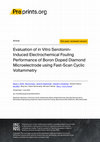
Fast-scan cyclic voltammetry (FSCV) is an electrochemical sensing technique that can be used for ... more Fast-scan cyclic voltammetry (FSCV) is an electrochemical sensing technique that can be used for neurochemical sensing with high spatiotemporal resolution. Carbon fiber microelectrodes (CFMEs) are traditionally used as FSCV sensors. However, CFMEs are prone to electrochemical fouling caused by oxidative byproducts of repeated serotonin (5-HT) exposure, which makes them less suitable as a chronic 5-HT sensor. Our team is developing a boron-doped diamond microelectrode (BDDME) that has previously been shown to be relatively resistant to fouling caused by protein adsorption (biofouling). We sought to determine if the BDDME exhibits resistance to electrochemical fouling, which we explored on electrodes fabricated with either femtosecond laser cutting or physical cleaving. We recorded the oxidation current response after 25 repeated injections of 5-HT in a flow-injection-cell and compared the current drop from the first to the last injection. The 5-HT responses were compared to dopamine (DA), a neurochemical that is known to produce minimal fouling oxidative byproducts and have a stable repeated response. Physical cleaving of the BDDME yielded a reduction in fouling due to 5-HT compared to the CFME and the femtosecond laser cut BDDME. However, the femtosecond laser cut BDDME exhibited a large increase in sensitivity over the cleaved BDDME. An extended stability analysis was conducted for all device types following 5-HT fouling tests. This analysis demonstrated an improvement in the long-term stability of boron doped diamond over CFMEs, as well as a diminishing sensitivity of the laser cut BDDME over time. This work reports the electrochemical fouling performance of the BDDME when it is repeatedly exposed to DA or 5-HT, which informs the development of a chronic, diamondbased electrochemical sensor for long-term neurotransmitter measurements in vivo.
This article shows the effect of hand-cleaved (HC), Nd:Yag laser, and femtosecond (FS) laser cutt... more This article shows the effect of hand-cleaved (HC), Nd:Yag laser, and femtosecond (FS) laser cutting of boron-doped diamond (BDD) electrodes on the sensing performance of heavy metal. Scanning electron microscopy (SEM) confirms diamond structures and Raman spectroscopy confirms changes in sp 2 and sp 3 contents in BDD microfiber electrodes (BDDMEs) under various cutting conditions.
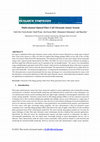
We report a multiplexed fiber-optic ultrasonic sensor system with four sensors fabricated on a si... more We report a multiplexed fiber-optic ultrasonic sensor system with four sensors fabricated on a single span of optical fiber. Each of the sensors is a fiber coil with two identical fiber Bragg gratings (FBGs) on the ends of the coil that form a low-finesse Fabry-Perot (FP) interferometer. The reflection spectrum of each sensor features dense sinusoidal fringes with a spectral profile determined by the FBGs. The FBGs for each of sensors have different wavelength so that their signal (the reflection spectra) can be separated in the wavelength domain. The sensors were demodulated using a modified phase-generated carrier (PGC) scheme, which involves modulating the phase of the laser to generate carrier signals that can be used to extract the ultrasound signal. The interferometer is designed to have a high sensitivity and a wide bandwidth. Toward practical applications, we integrated the demodulation circuit into a PCB circuit board. The ultrasound sensor system demonstrated here has many advantages over conventional piezoelectric sensors with the potential to overcome the limitations of other fiber-optic ultrasonic sensors, which makes them an attractive option for applications in nondestructive evaluation and structural health monitoring.
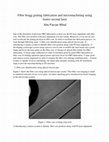
One of the drawback of previous FBG fabrication system was the FS laser alignment with fiber core... more One of the drawback of previous FBG fabrication system was the FS laser alignment with fiber core. The fiber core position with laser alignment was not certain. Moreover, it was not an easy task to relocate the grating position in fiber core. In order to facilitate the fabrication process, we went through following steps: 1) fiber core identification using optical microscope, 2) introducing a camera system to identify fiber core position along with FS laser alignment. 3) developing a telescope system using concave-convex lens to modify the laser beam into a point shape and focus the laser point on the fiber core, 4) Design of optical fiber holder for FBG fabrication, 5) linear stage calibration in order to introduce point by point FBG fabrication in fiber core, 6) finding optimum optical power and laser focus for FBG fabrication, 7) laser point and camera system alignment in order to monitor the fiber core damage simultaneously ,. Current system is capable of micro-machining. our future plan includes working with 3D translation stage to provide micromachining in 3D structure.
arXiv preprint arXiv:2210.07156, 2022
Fiber bragg gratings (FBG) has wide variety of applications in sensor and laser devices. In this ... more Fiber bragg gratings (FBG) has wide variety of applications in sensor and laser devices. In this work, we have fabricated FBG using point by point (PbP) technique utilizing fs laser. FBGs spectral characteristics were explored through the variation of grating length, fiber holder position, laser power and coated layer. Fs FBG is fabricated on small mode field diameter fiber which shows enhancement of transmission depth to 2.5 dB. The center wavelength shift is observed from 1520 nm to 1568 nm with the change in translational stage speed. The fs FBGs can be utilized in high pressure sensing, high temperature sensing and hazardous environment monitoring purposes.
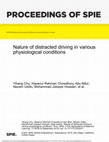
Proc. SPIE 11139, Applications of Machine Learning, 111391B , 2019
Road traffic injury has appeared as a severe problem today, claiming more than 1.25 million lives... more Road traffic injury has appeared as a severe problem today, claiming more than 1.25 million lives each year worldwide and draining 3% of the total global GDP. According to the National Highway Transportation Safety Administration, about half a million people got injured in 2014 due to distracted driving related car clashes. In this work, we have considered the brainwave, heart rate and blood pressure level of a distracted driver. Within the various source of distraction (e,g, multi-tasking, severe weather condition, external sound effects) we monitored the driving behavior through EEG signal. In particular, the alpha, beta, gamma, delta and theta brainwaves have a significant connection with the emotion, stress and other psychological responses. Our EEG data analysis can provide a pathway to detect the physiological condition of distracted drivers and avoid road accidents.
Generation of microbubble has wide range of applications in the fields of pharmacology, medicine,... more Generation of microbubble has wide range of applications in the fields of pharmacology, medicine, food industry and material science. Recent researches show that, microbubble can be utilized for controlled drug delivery system in the affected cells and tissues. Cavitation process of microbubble can help in transportation of external substances across biological barriers by orders of magnitude over diffusive transport which can eventually create a platform for effective drug delivery into the targeted cells. Here, we are working on the generation of cavitation process of microbubble through photothermal effect on nanoporous gold disc (NPGD).
Polarization is a fundamental property of light and an important concept in the field of optics [... more Polarization is a fundamental property of light and an important concept in the field of optics [2]. Three different polarization states can exist e.g, linear circular and elliptical. In this experiment, we studied polarization of light through a laser light source, polarizers, and retarders (called wave plates). Our calculated Brewster angle was 56.31̊ , while polarizer angle was set to 55 ̊ and the laser source was rotated at an angle of 56 ̊. In later parts, we calculated the refractive index of the glass using Fresnel Rhomb. Our calculated refractive index of the glass be 1.2, 1.43 (using Brewster angle) and 1.48 (using minimum deviation technique). Finally, we studied the depolarization of light upon reflection through linear polarization.
Optical methods are most popular speed measurement techniques due to its non-destructive and non-... more Optical methods are most popular speed measurement techniques due to its non-destructive and non-contact in nature. Speed measurement by optical techniques are suitable for all sizes of objects. In this experiment, we dealt with transverse speed measurement and Doppler shift measurement for the speed of train and rotating wheel. Fast rotating wheel in transverse speed measurement provided beat frequency of 1.87 MHz while our calculated beat frequency and fringes period were 2.47 MHz and 8.72 um, respectively. For slow moving wheel, the beat frequency was ~91 KHz and the calculated velocity for rotating wheel was 0.03392 m/s using the Doppler shift technique. The beat frequency for the moving train ranges from 266.304 KHz to 923.913 KHz for train speed of 0.068 m/s and 0.26 m/s.
Helium-Neon or HeNe laser is a type of gas laser, which have many industrial and scientific uses ... more Helium-Neon or HeNe laser is a type of gas laser, which have many industrial and scientific uses and are often used in laboratory demonstrations of optics. In this experiment, we worked in the basic cavity alignment of a He-Ne laser using another commercial He-Ne laser. Finally, we went through power and beam profile measurement, longitudinal modes and speed of light measurement of our newly constructed He-Ne laser. The laser operates at 632.8 nm and the maximum output power is 2.6 mW.
A 1064 nm wavelength laser was obtained by pumping a Nd:YVO4 crystal using a 808 nm wavelength di... more A 1064 nm wavelength laser was obtained by pumping a Nd:YVO4 crystal using a 808 nm wavelength diode laser. A curved and a flat mirror were used to examine two different cavity mirrors. The Q-switching of this laser was realized using a saturable absorber. Second harmonic generation was performed to obtain both continuous wave and Q-switched 532 nm wavelength laser.
Generation of microbubble has wide range of applications in the fields of pharmacology, medicine,... more Generation of microbubble has wide range of applications in the fields of pharmacology, medicine, food
industry and material science. Recent researches show that, microbubble can be utilized for controlled drug
delivery system in the affected cells and tissues. Cavitation process of microbubble can help in
transportation of external substances across biological barriers by orders of magnitude over diffusive
transport which can eventually create a platform for effective drug delivery into the targeted cells. Here, we
are working on the generation of cavitation process of microbubble through photothermal effect on
nanoporous gold disc (NPGD).
Generation of microbubble has wide range of applications in the fields of pharmacology, medicine,... more Generation of microbubble has wide range of applications in the fields of pharmacology, medicine, food
industry and material science. Recent researches show that, microbubble can be utilized for controlled drug
delivery system in the affected cells and tissues. Cavitation process of microbubble can help in
transportation of external substances across biological barriers by orders of magnitude over diffusive
transport which can eventually create a platform for effective drug delivery into the targeted cells. Here, we
are working on the generation of cavitation process of microbubble through photothermal effect on
nanoporous gold disc (NPGD).

In this subsistent fifth generation era, InxGa1-xN/GaN based materials have played an imperious r... more In this subsistent fifth generation era, InxGa1-xN/GaN based materials have played an imperious role and become promising contestant in the modernistic fabrication technology because of some of their noteworthy attributes. On our way of illustrating the performance, the structure of InxGa1-xN/GaN quantum dot (QD) intermediate band solar cell (IBSC) is investigated by solving the Schrödinger equation in light of the Kronig-Penney model. In comparison with p-n homojunction and heterojunction solar cells, InxGa1-xN/GaN IBQD solar cell manifests larger power conversion efficiency (PCE). PCE strongly depends on position and width of the intermediate bands (IB). Position of IBs can be controlled by tuning the size of QDs and the Indium content of InxGa1-xN whereas, width of IB can be controlled by tuning the interdot distance. PCE can also be controlled by tuning the position of fermi energy bands as well as changing the doping concentration. In this work, maximum conversion efficiency is found approximately 63.2% for a certain QD size, interdot distance, Indium content and doping concentration.

Low bandgap polymer solar cells have a great deal of importance in flexible pho-tovoltaic market ... more Low bandgap polymer solar cells have a great deal of importance in flexible pho-tovoltaic market to absorb sun light more efficiently. Efficient wide bandgap solar cells are always available in nature to absorb visible photons. The development and incorporation of infrared photovoltaics (IR PV) with wide bandgap solar cells can improve overall solar device performance. Here, we have developed an efficient low bandgap polymer solar cell with CsF as interfacial layer in regular structure. Polymer solar cell devices with CsF shows enhanced performance than Ca as inter-facial layer. The power conversion efficiency of 4.5% has been obtained for PDPP3T based polymer solar cell with CsF as interlayer. Finally, an optimal thickness with CsF as interfacial layer has been found to improve the efficiency in low bandgap polymer solar cells. © 2018 Author(s). All article content, except where otherwise noted, is licensed under a Creative Commons Attribution (CC BY) license
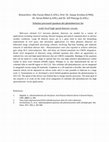
Solution processed quantum dot photodetectors for wafer level high speed detector circuits Mid-wa... more Solution processed quantum dot photodetectors for wafer level high speed detector circuits Mid-wave infrared (3-5 microns) photonic detectors are needed for a variety of applications including chemical sensing, thermal imaging and optical communication in adverse weather conditions. Large IR detector arrays are in a great need to meet the demanding requirements of civil space and astronomy applications [1]. Most photonic detectors are fabricated using complicated processing schemes involving flip-chip bonding and substrate removal of individual detector dies. Phototransistors were also reported to achieve sufficient gain using III-V semiconductors. But, still these are limited potentials for CMOS integration. Wafer level integration of detectors using colloidal quantum dots offers an opportunity to realized low cost and high-speed detectors that are CMOS compatible. Bandgap of the quantum dots can be tuned in a wide range to operate this low cost high sensitive photodetectors within visible to short wave infrared (SWIR) region. Philippe et. al. also demonstrated the use of colloidal QDs in mid-IR region in 2012 [2]. This colloidal QD photodetectors can be integrated in integrated circuits using 2D materials. Graphene as a 2D material is flexible, thin and durable material which can be deposited on silicon wafer and it is also possible to fabricate in a large scale. G. Konstantatos et. al. developed a novel hybrid graphene-quantum dot phototransistor in 2012 . The speed of this device was limited due to charge transfer processes. The main goal of our research is to work on the wafer level integration of colloidal QD photodetectors for high speed photonic circuit applications.
Background and statement of the problem: Directed energy weapons (DEW) have drawn a great deal of... more Background and statement of the problem: Directed energy weapons (DEW) have drawn a great deal of attention during the past few years in the army laser weapon systems. Laser beams neither produces sound nor it deviates from the target. Moreover, laser can travel with light speed. Detection, recognition and tracking of targets under a wide range of atmospheric conditions is one of the major issues in this DEW system [1].

Colloidal Quantum Dot light emitting diode (QLED) is considered to be a potential candidate for t... more Colloidal Quantum Dot light emitting diode (QLED) is considered to be a potential candidate for the next generation display technology. Researchers have already achieved ~20% external quantum efficiency (EQE) in Cd-based red emitting QD LEDs [1]. Near Infrared QD LEDs have potential applications in biomedical imaging, optical telecommunications and computing, onchip bio(sensing), spectroscopy and night-vision-readable displays. Due to lack of low bandgap organic dyes and semiconductor polymers, NIR LED technology could not be developed. QDs have the potential to tune the wavelength in IR region [2]. In 2015 Supran et. al. achieved 4.3% EQE in Cd based NIR QLEDs . In order to overcome the toxicity problem in Cd based devices, InP QDs, AgInSe2, ZnSe QDs, CuInS2 based QDs and carbon dots have already been developed. CuInSe IR emitting QDs can be an attractive candidate for non-toxic NIR LEDs.









Uploads
Papers by Abu Mitul, Ph.D.
used for neurochemical sensing with high spatiotemporal resolution. Carbon fiber microelectrodes
(CFMEs) are traditionally used as FSCV sensors. However, CFMEs are prone to electrochemical
fouling caused by oxidative byproducts of repeated serotonin (5-HT) exposure, which makes them
less suitable as chronic 5-HT sensors. Our team is developing a boron-doped diamond microelectrode
(BDDME) that has previously been shown to be relatively resistant to fouling caused by protein
adsorption (biofouling). We sought to determine if this BDDME exhibits resistance to electrochemical
fouling, which we explored on electrodes fabricated with either femtosecond laser cutting or physical
cleaving. We recorded the oxidation current response after 25 repeated injections of 5-HT in a flowinjection cell and compared the current drop from the first with the last injection. The 5-HT responses
were compared with dopamine (DA), a neurochemical that is known to produce minimal fouling
oxidative byproducts and has a stable repeated response. Physical cleaving of the BDDME yielded a
reduction in fouling due to 5-HT compared with the CFME and the femtosecond laser cut BDDME.
However, the femtosecond laser cut BDDME exhibited a large increase in sensitivity over the cleaved
BDDME. An extended stability analysis was conducted for all device types following 5-HT fouling
tests. This analysis demonstrated an improvement in the long-term stability of boron-doped diamond
over CFMEs, as well as a diminishing sensitivity of the laser-cut BDDME over time. This work reports
the electrochemical fouling performance of the BDDME when it is repeatedly exposed to DA or 5-HT,
which informs the development of a chronic, diamond-based electrochemical sensor for long-term
neurotransmitter measurements in vivo.
industry and material science. Recent researches show that, microbubble can be utilized for controlled drug
delivery system in the affected cells and tissues. Cavitation process of microbubble can help in
transportation of external substances across biological barriers by orders of magnitude over diffusive
transport which can eventually create a platform for effective drug delivery into the targeted cells. Here, we
are working on the generation of cavitation process of microbubble through photothermal effect on
nanoporous gold disc (NPGD).
industry and material science. Recent researches show that, microbubble can be utilized for controlled drug
delivery system in the affected cells and tissues. Cavitation process of microbubble can help in
transportation of external substances across biological barriers by orders of magnitude over diffusive
transport which can eventually create a platform for effective drug delivery into the targeted cells. Here, we
are working on the generation of cavitation process of microbubble through photothermal effect on
nanoporous gold disc (NPGD).
used for neurochemical sensing with high spatiotemporal resolution. Carbon fiber microelectrodes
(CFMEs) are traditionally used as FSCV sensors. However, CFMEs are prone to electrochemical
fouling caused by oxidative byproducts of repeated serotonin (5-HT) exposure, which makes them
less suitable as chronic 5-HT sensors. Our team is developing a boron-doped diamond microelectrode
(BDDME) that has previously been shown to be relatively resistant to fouling caused by protein
adsorption (biofouling). We sought to determine if this BDDME exhibits resistance to electrochemical
fouling, which we explored on electrodes fabricated with either femtosecond laser cutting or physical
cleaving. We recorded the oxidation current response after 25 repeated injections of 5-HT in a flowinjection cell and compared the current drop from the first with the last injection. The 5-HT responses
were compared with dopamine (DA), a neurochemical that is known to produce minimal fouling
oxidative byproducts and has a stable repeated response. Physical cleaving of the BDDME yielded a
reduction in fouling due to 5-HT compared with the CFME and the femtosecond laser cut BDDME.
However, the femtosecond laser cut BDDME exhibited a large increase in sensitivity over the cleaved
BDDME. An extended stability analysis was conducted for all device types following 5-HT fouling
tests. This analysis demonstrated an improvement in the long-term stability of boron-doped diamond
over CFMEs, as well as a diminishing sensitivity of the laser-cut BDDME over time. This work reports
the electrochemical fouling performance of the BDDME when it is repeatedly exposed to DA or 5-HT,
which informs the development of a chronic, diamond-based electrochemical sensor for long-term
neurotransmitter measurements in vivo.
industry and material science. Recent researches show that, microbubble can be utilized for controlled drug
delivery system in the affected cells and tissues. Cavitation process of microbubble can help in
transportation of external substances across biological barriers by orders of magnitude over diffusive
transport which can eventually create a platform for effective drug delivery into the targeted cells. Here, we
are working on the generation of cavitation process of microbubble through photothermal effect on
nanoporous gold disc (NPGD).
industry and material science. Recent researches show that, microbubble can be utilized for controlled drug
delivery system in the affected cells and tissues. Cavitation process of microbubble can help in
transportation of external substances across biological barriers by orders of magnitude over diffusive
transport which can eventually create a platform for effective drug delivery into the targeted cells. Here, we
are working on the generation of cavitation process of microbubble through photothermal effect on
nanoporous gold disc (NPGD).
Applications” welcomes contributions that address
innovative aspects such as the design and deployment of
advanced fiber optic sensors, the application of fiber
sensing in non-destructive and ultrasonic detection, and
enhancements in optical atmospheric remote sensing.
Specific topics of interest include, but are not limited to,
the following:
1)Development and validation of novel fiber optic
sensors and sensing methodologies, especially those
incorporating Lidar and other optical sensing technologies;
2)Applications of fiber optic sensing;
3) Integration of fiber optic sensors with other
technologies;
4)Advancements in data processing, including machine
learning and big data analysis;
5)Fiber optic sensing with AI applications, including
boosting sensing performance with AI models, addressing
AI security issues that introduced by fiber optic techniques,
and other real-world applications that combine AI with
fiber optic sensing technologies.
6)Exploration of microfluidics and optofluidic, and their
applications in chemical, biological, and pharmaceutical
industries.
On behalf of the Organizing Committee, we welcome you to propose a speech as a speaker on your recent solar energy project for the Session 2-7: Perovskite Solar Cells of the Track 2: Breakthroughs of PV Technology at the upcoming 1st Solar Energy Forum-2016 (SEF-2016), which will be held during November 10-12, 2016 in Qingdao, China. Your prompt reply with a speech proposal will be highly appreciated! You may refer to the topics list below:
Track 1: Solar Energy Policy, Market Trend and Financial
Track 2: Breakthroughs of PV Technology
Track 3: Best Practice of Solar Energy
Track 4: Solar Energy Products and Applications
The 1st SEF-2016 plans to shoot for 100+ oral presentations from the field of solar energy. It is intended to provide a platform for professionals around the world to exchange state-of-the-art research and development and identify research needs and opportunities in this emerging field. We believe the SEF-2016 will bring about enormous benefits as well as open up a new and broader pathway for information and experience exchange between China and the rest of the world.
For more information regarding SEF-2016, please visit our conference website at http://www.bitcongress.com/sef2016/
We look forward to your active support and participation.
Sincerely Yours,
Ms. Eva
BIT Congress, Inc.
----Your Think Tank
Program Coordinator of SEF-2016
11F, No.1 Hui Xian Yuan
Dalian Hi-tech Industrial Zone
Dalian, LN 116025, P.R.China
Tel: +86-411-84799609 ext. 889
Fax: +86-411-84795469
Email: eva@nefconference.com
Website: http://www.bitcongress.com/sef2016/
208
Florida. Over the next three years, six additional successful workshops were organized on various focus topics in
materials science, and grouped under the title of “Villa Conference” in honor of the original 2008 Orlando
meeting. The Villa Conference series has grown rapidly beyond the traditional villa setting, continuing to attract
highly-quality contributions from members of the international scientific and engineering communities. In 2012
the first Conference with a broader theme of Energy, Materials and Nanotechnology was held. The EMN
Meetings now include five annual gatherings: EMN Fall (Orlando), EMN Spring (Las Vegas), EMN Summer
(Cancun), EMN East (Beijing), and EMN Open (Chengdu).
The 2016 EMN Beijing Meeting is a new development in this series, in response to growing interests from
additional participants on this conference theme. It's going to be a unique platform for leading scientists,
researchers, scholars and engineers from academia, R&D laboratories and industries around the world to
exchange, share and learn the most recent advancement on various aspects related to energy, materials and
nanotechnology.
Applications” welcomes contributions that address
innovative aspects such as the design and deployment of
advanced fiber optic sensors, the application of fiber
sensing in non-destructive and ultrasonic detection, and
enhancements in optical atmospheric remote sensing.
Specific topics of interest include, but are not limited to,
the following:
1)Development and validation of novel fiber optic
sensors and sensing methodologies, especially those
incorporating Lidar and other optical sensing technologies;
2)Applications of fiber optic sensing;
3) Integration of fiber optic sensors with other
technologies;
4)Advancements in data processing, including machine
learning and big data analysis;
5)Fiber optic sensing with AI applications, including
boosting sensing performance with AI models, addressing
AI security issues that introduced by fiber optic techniques,
and other real-world applications that combine AI with
fiber optic sensing technologies.
6)Exploration of microfluidics and optofluidic, and their
applications in chemical, biological, and pharmaceutical
industries.
TBD Final Job Offer for Adjunct Physics is attached here.